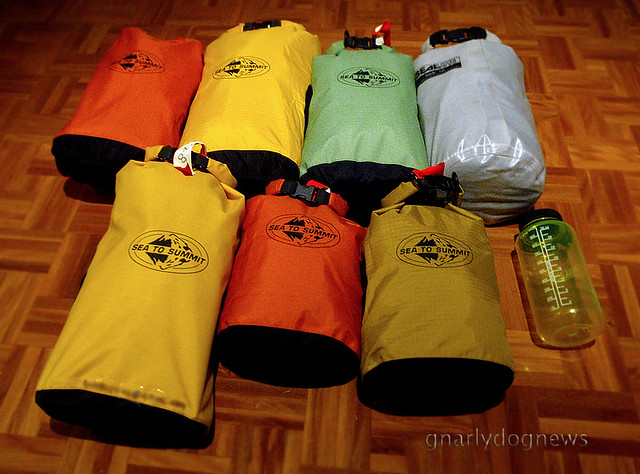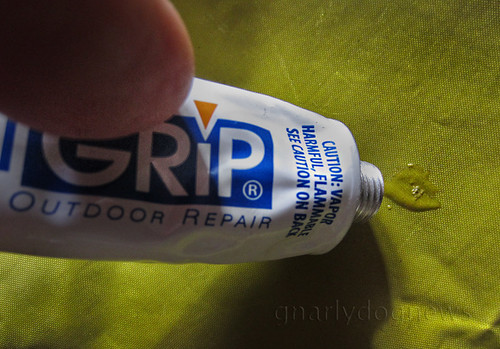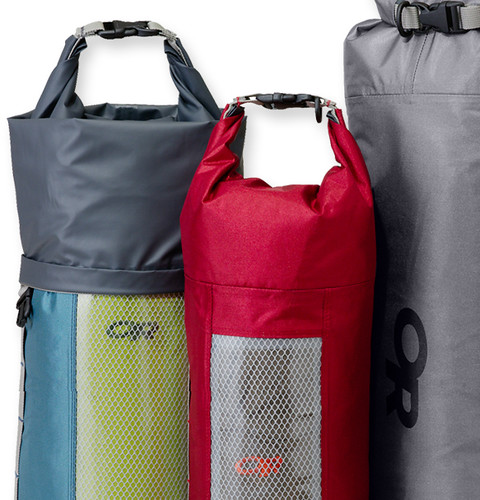Dry bags come in so many different types, shapes and sizes that one is often puzzled by the choice.
My findings stretch over 15 years of using dry bags, and not just for paddling.
Unfortunately the old adage that says: "you get what you pay for" is not always true.
I had some dry bags that despite costing much more than others performed poorly.
The most critical thing for me is the shape and size of a bag and how well it fits in a sea kayak.
When I transitioned from canoeing to sea kayaking I found that most of the dry bags I owned were too large. For efficiently packing of my gear and food for long trips, small bags fit better in the tight confinements of the hatches.
While a large dry bag will contain obviously more gear and cost less than two smaller ones, I find that dry bags that are larger than 15 liters are not as easy to use as smaller ones. I have a bag of 25 liters that I never use for sea kayaking: it just doesn't fit in my boats.
Since sea kayaks tend to have limited size hatches and the hull shape is long and pointy at the ends, small bags can be arranged easier around the confined space of the hatch. Of course if your kayak is a barge you have to pay much less attention to how you pack. :-)

14 days worth of food for two paddlers
I don't own tapered dry bags since I find the very skinny bow and stern of the kayak suited to store items that don't need to be kept imperatively dry (like tent poles). My favorite size bag is 8 liters.
The material/fabric of a dry bag is very critical in my opinion. The very light ones made from siliconized nylon are not suited for waterproofing items placed in the hatch.
While a decent kayak should have dry hatches most don't. A combination of sloppy workmanship, bad design, user error and deteriorated hatch covers lead to leaks in the supposedly dry hatches.
Items tend to get wet occasionally. Experienced showed me that Silnylon just isn't sturdy enough to prevent being punctured, on the surface of the fiberglass or around camp. Even if some of my kayaks are perfectly smooth inside, the items that the bag contains are often hard and abrade the fabric when jammed inside the hatch.
The clear PVC bags usually seem to offer good protection against abrasion, for a while, but when they puncture they are really hard to repair (I had no luck). Over time mine failed where the fabric folds over at the closure area.
My favorite dry bags are made of woven nylon fabric exterior that have a waterproof coating on the inside of the fabric.
As the bags get dropped on sharp ground and occasionally abraded against the hull, repairing the nylon fabric is extremely easy.

A dob of Seam Grip will patch any leak.
Fabric-type bags also tend to be less bulky when folded over to seal and slide easier when pushed inside the hatch. They also don't have the sticky surface to grab your pots or hard shiny object when cramming them.
Siliconized nylon is however a great material for storing you sleeping bag that should be then placed inside a second dry bag.
Dry bags are NOT submersible and, in the event of a hatch flooding, the water will seep inside a dry bag; so it's good practice to keep the sleeping bag in a double dry bag, especially if the hatches aren't positively sealed.
The ultimate dry bag has two roll-down-buckle closures. The first one will keep most of the water out and prevent a pressure leak on the second one. The second one will prevent any moisture that has crept past the first closure going inside the bag.
These double dry bags are the bomb:

Obviously when backpacking all I need is a decent siliconized nylon dry bag since there is no water pressure on the closure, just potential rain that leaks inside backpack.
Like all fabric items, dry bags require some minimal maintenance: keep them relatively clean and dry.
A bag left wet inside the kayak for a prolonged period of time will develop mould and probably fail prematurely.
My favorite bags:
Sea to Summit Big River, for most of my "hard" gear when sea kayaking (food, utensils, repair kit)
Outdoor Research Durable Dry Sack for clothing and sleeping bags (inside a second bag) when sea kayaking.
Outdoor Research Ultralight Dry Sack for clothing and sleeping bag when backpacking.
I also use some Seal Line bags for items that might have hard items stored (kitchen)



There is an article in California Kayaker Magazine on dry storage. It didn't get into the detail you did on the pros and cons of dry bag materials, but did cover some other types of dry storage (boxes, etc.). And has an example from a kayak incident that shows that dry bags are not submersible. Can be read online for free at
ReplyDeletehttp://content.yudu.com/Library/A1q785/CaliforniaKayakerMag/resources/26.htm
Peter, thank you for the link to a very interesting article. BTW, the whole mag is very good!
ReplyDeleteBravo, Damiano. A really great, informative, and detailed post on an essential subject not often covered. I particularly appreciated reading about your experience with different fabrics / materials, and I share your feeling about double-bag systems. I'm constantly amazed by the design, variety, and quality of a lot of the new gear. Also, thanks for the hot link to McNett for the Seam Grip. First time I'd heard of them. An interesting company with a lot of repair products, tips etc.
ReplyDeleteBack in the dinosaur days we used plastic garbage bags to keep our stuff dry - whether it was canoeing, backpacking, mountaineering, whatever. Double bagged the sleeping bag inside the stuff sack. Not submersible forever, but good for a minute or two underwater or days and days in the pouring rain.
Technique was to insert the garbage bags into the stuff sack, stuff in the bag, close the first garbage bag with a tight twist after pressing out any excess air, fold the tightly twisted top over and do the same with the second garbage bag. Finally, close the stuff sack. Been through some gnarly (forgive me) rainstorms and whitewater capsizes, and never had a problem. Used this technique for clothing and anything else that we didn't want to get wet.
Moulton Avery
Just finished testing a bunch of different brand drybags. The only one I found that can keep the water out was the Outdoor Research Double dry bag. You do mention that one I see above. I also tried the outdoor Research Durable drybag but like all the others they leak at the roll up. Thats the weak point of every drybag I tested. Since the double roll up has two sets to leak through they actually worked best. I tested the bags in my actual kayak.I poured water into the front hatch, about 3 cups worth and stuck the bag being tested into the low point in the hatch with the roll section down near the low point. Left them in 1 hour and all single roll tops leaked quite a bit of water in them. The double roll bag let water past the first roll and only a few drops got by second roll. By far much better than any single roll up drybag. NON of the bags leaked past the material itself not even the cheapest ones I tested. Its all by the roll up section of the bags, even rolling them 4 times over. So without a doubt either get the Outdoor Research double roll up bags or double up your bags. Also what worked well use regular drybag with single roll up then plastic trash bag inside synched up tight with rubber bands. Oh I also tried just spraying bags with garden hose while setting on ground and all kept the water out. Only sprayed for a few minutes though.
ReplyDeleteThank you for contributing your findings on the dry bags. As you mention dry bags are only dry if not immersed as the roll-down closure does not create a leak proof seal. Any water pressure (even if small) will let water in the bag. I would never recommend using dry bags for sensitive equipment like electronics if there is a chance of water pooling in the hatches.
DeleteNice article. I have found that using a few smaller dry bags is better to pack and fit into my kayak. Thanks
Delete